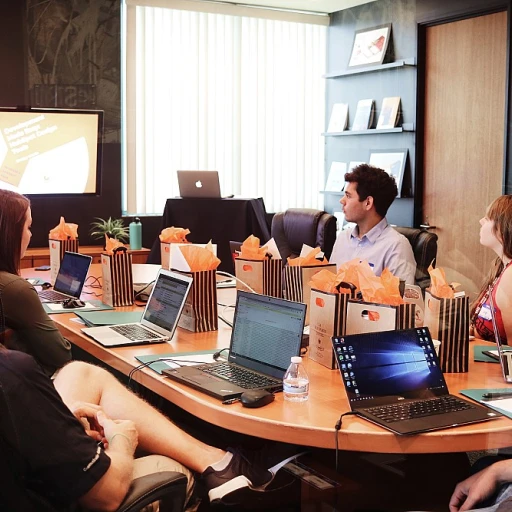
Understanding the Need for Reskilling
Recognizing the Imperative
In today's rapidly evolving world, the concept of reskilling has emerged as a critical strategy for businesses seeking to maintain a competitive edge. As industry landscapes shift, organizations must adapt to new trends ensuring that their workforce remains efficient and capable of meeting new demands. Reskilling stands as a vital process in enhancing workforce performance, aligning with essential management practices that focus on continuous improvement.
The significance of reskilling lies in its potential to boost employee performance and engagement, leading to a more dynamic and productive work environment. As industries advance, the gap between existing skills and those required for future job roles widens. There is a pressing need to address this gap proactively. Strategies such as customized training and development programs are key to this endeavor. These initiatives not only improve work performance but also contribute to a holistic employee experience.
Employers must focus on equipping their teams with the skills needed to tackle future challenges. This involves identifying emerging skill sets that will be critical for future job performance and integrating them into comprehensive reskilling plans. In addition, effective performance management systems should be in place to track employee progress, using data to gauge the success of these initiatives in real-time.
Building a culture of continuous learning means engaging employees in regular check-ins and performance reviews where feedback can be given and new development paths can be outlined. This approach ensures that employees feel valued and motivated, driving high performance and better workforce productivity.
An essential aspect of reskilling is cultivating an adaptive mindset among employees. Encouraging adaptability facilitates a smoother transition as they learn new skills, which is a must in an era where change is the only constant. By fostering this mindset, companies can support their teams in navigating the complexities of industry transformations, ultimately enhancing long-term business success.
Identifying Key Skills for Future Success
Essential Competencies for a Resilient Workforce
Reskilling is not just about learning new technologies, it’s about aligning skill sets with future requirements. Understanding which competencies are essential helps management tailor training programs to improve employee performance and satisfaction. Identifying key skills involves a comprehensive analysis of current performance metrics and forecasting future business needs. Company leaders often utilize data-driven insights and feedback to pinpoint developmental areas. This approach aligns with best practices in performance management, ensuring that employees gain relevant skills to bolster workforce performance. Organizations must direct their attention to areas such as:- Digital Literacy: With technology being an integral part of business processes, having a digitally proficient team enhances productivity and competitiveness.
- Critical Thinking: As businesses tackle complex problems, nurturing the ability to analyze and resolve issues effectively becomes paramount.
- Emotional Intelligence: Understanding team dynamics and improving manager-employee relationships are essential for fostering a positive employee experience.
Aligning Skills with Goals
The alignment of skills with company goals ensures that reskilling efforts are not just short-term fixes but pivotal in achieving long-term objectives. Transforming job performance requires a clear definition of what high performance looks like in the context of the organization's aspirations. Incorporating a continuous learning culture where regular check-ins and feedback are part of the management process guarantees sustained engagement. Employees feel valued and motivated to contribute towards common goals, boosting overall workforce efficiency. Incorporating these strategies—and mastering the art of improvisation—into reskilling initiatives creates a robust framework for adapting to change and fostering engagement. Ultimately, identifying the right skills for future success involves an integrated approach considering individual employee aspirations, team goals, and broader business strategies. This ensures a harmonious balance between personal development and organizational growth, paving the way for enhanced work performance and excellence.Strategies for Effective Reskilling Programs
Crafting Successful Reskilling Programs
Reskilling is an essential strategy for maintaining a high-performance workforce. To build effective reskilling programs, several strategies must be employed, beginning with setting clear objectives. The goals of these programs should align with overall business objectives and cater to both the professional development of employees and the achievement of company goals. Engagement is also crucial in maintaining the interest and commitment of team members. It's beneficial for managers to incorporate regular check-ins and feedback sessions as part of the reskilling process. These can help enhance employee engagement and offer insights into how employees feel about their development progress. Incorporating technology plays a critical role in streamlining the management process of reskilling programs. Innovative management systems that utilize real-time data can significantly improve employee performance by providing personalized training recommendations and tracking workforce performance metrics. Understanding which skills are in demand is vital to tailor training efforts effectively. Read more about mastering the art of becoming a learning strategist here. Performance management is another crucial component. It requires a systematic approach to assessing how employees are progressing within their new roles and responsibilities. Regular performance reviews help highlight areas for improvement and recognize high-performing employees' achievements, creating a motivating experience. Ensuring long-term success involves reinforcing these new skills by integrating them into everyday work tasks and real-time problems. This practice not only improves job performance but enhances the overall employee experience and productivity, ensuring that the workforce remains engaged and committed to the company's vision for the future.Overcoming Challenges in Reskilling
Recognizing and Addressing Reskilling Hurdles
Reskilling is a vital component of maintaining workforce performance and employee engagement, but it is not without its challenges. Overcoming these obstacles requires a multi-faceted approach, involving management, employee feedback, and strategic development plans.
One of the primary hurdles is the management of time and resources. Many businesses face the challenge of allocating sufficient time and funds to training while balancing daily operations. Ensuring employees can dedicate time to their reskilling without hampering job performance is crucial. Managers should implement smart scheduling and prioritize essential training sessions to align with the company’s long-term goals.
Navigating Employee Resistance
Employee resistance can significantly affect the success of reskilling initiatives. To overcome this, it is essential to promote an inclusive work environment where team members feel empowered to voice their concerns. Regular, real-time feedback and performance reviews can help gauge employee experience and engagement, making the reskilling process more receptive and adaptive.
Another strategy to counter resistance is by clearly communicating the value of reskilling to the workforce. Highlight how these programs lead to improved employee performance, enhanced productivity, and better alignment with business objectives. When employees understand the benefits, they are more likely to engage in reskilling efforts.
Integrating Technology and Data
The integration of technology into the reskilling process can present both challenges and opportunities. Advanced analytics and performance management systems can be leveraged to track performance metrics, enhancing understanding of workforce development needs. However, it’s vital to address any technological gaps and ensure that employees are equipped with the necessary skills to utilize these tools effectively.
To maximize the impact of reskilling initiatives, businesses should adopt best practices from the field. This involves staying updated with emerging trends such as AI-driven learning tools, and fostering a culture of continuous improvement and adaptability.
Maintaining Long-term Outcomes
Ensuring the sustainability of reskilling efforts requires a shift from short-term projects to a long-term management process. Performance management frameworks that incorporate regular check-ins and feedback loops can help track progress and align training programs with evolving business needs. Building a robust foundation for workforce development will result in high performance and sustained improvement across the company.
The Role of Technology in Reskilling
Harnessing Technological Innovations for Skill Development
In today’s rapidly evolving business landscape, technology has emerged as a pivotal tool in reshaping workforce dynamics, particularly in reskilling initiatives. Leveraging technology allows for more efficient management of employee development programs and enhances overall workforce performance. Firstly, technology enables real-time performance management. With modern management systems, feedback and performance metrics can be collected and analyzed continuously. This real-time data equips managers with valuable insights into employee performance, enabling timely interventions and personalized training. By setting clear goals and monitoring job performance, employees receive targeted support that aligns with both their personal development and company objectives. Moreover, digital platforms facilitate tailored training programs. Online courses and virtual workshops provide employees with flexible learning opportunities, catering to different learning paces and preferences. This flexibility enhances employee engagement and fosters a high-performance culture, as team members can focus on developing skills that directly impact their roles and the business. Utilizing performance reviews and personal development data, companies can integrate AI-driven solutions to predict future skill requirements and workforce needs. This predictive capability helps in designing sustainable long-term strategies for employee growth and business success. Additionally, technology streamlines the reskilling process with interactive tools and real-time check-ins. Employees feel more connected and supported, which improves productivity and engagement levels. As performance management evolves, integrating these technological solutions into the reskilling framework ensures that both employees and the organization remain agile and competitive in the market. When implemented effectively, tech-enhanced reskilling not only boosts job and workforce performance but also contributes to a thriving business environment. Organizations should continuously explore best practices and stay informed about emerging trends in technology to drive successful reskilling initiatives.Future Trends in Workforce Reskilling
Reshaping Reskilling: What the Future Holds
The world of work is constantly evolving, and the future of reskilling is poised to reflect this dynamic nature. As businesses strive for high performance and increased productivity, the need for innovative strategies becomes paramount. Looking ahead, certain trends are likely to shape the landscape of workforce reskilling in profound ways.- Personalized Learning Experiences: Organizations are increasingly adopting a more individualized approach to training. This focuses on tailoring the learning process to the specific goals and job roles of employees. Through the integration of data analytics, businesses are better equipped to enhance employee performance by providing relevant, targeted skill development.
- Real-time Feedback and Engagement: Continuous feedback and engagement are essential in nurturing employee development. Frequent check-ins with team members allow management to gauge workforce performance and make adjustments as needed. This real-time approach helps employees feel more connected to their work and motivates them to meet performance metrics effectively.
- Leveraging Technology: Advanced technology, including AI and machine learning, plays a crucial role in designing reskilling programs that are both efficient and adaptive. These tools can streamline the management process, aiding managers in setting precise goals and tracking employee progress over time.
- Performance Management Evolution: Traditional performance reviews are evolving into more dynamic management systems. The focus is shifting from a solely evaluative approach to one that combines long-term employee engagement with immediate performance support. This new system fosters an empowering employee experience that drives job performance improvements.
- Collaborative Learning Environments: Promoting a community-based approach to learning enables employees to share knowledge and insights. Collaborative platforms facilitate team interactions, encouraging the collective development of skills and reinforcing the importance of team feedback in achieving business success.













